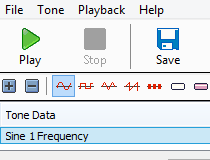

The Note Selector consists of a table of note buttons, ranging from C0 to B8, and a frequency slider. For example, White Noise does not have a frequency, and so the Note Selector is disabled when White Noise is selected. It will only expand when it makes sense for it to be used. Expand or collapse the Note Selector by clicking on its title. The Note Selector allows you to quickly choose the exact musical note you want. You can move up or down octaves using the PageUp or PageDown keys, or configure the +/- keys to increment or decrement by a frequency of your choice in the Tone Interval section of the Options dialog. This can be between 1Hz and 22000Hz (if supported by your sound card).įor musicians, the reference "concert" is 440Hz. To edit the value of an item, double click on it (or select it and press Enter). The details of a tone (each frequency and duration) are displayed and edited using the Tone Data list on the main window of NCH Tone Generator. Set the Tone Details (Frequencies / Duration/ Amplitude) Grey noise has a power spectrum that is designed to align with the human psychoacoustic equal loudness contour, such that the noise sounds equally loud at all frequencies. Violet noise is just like blue noise with an increase of 6 dB per octave yielding noise of a higher tone. Blue Noiseīlue noise emphasizes higher frequency components, increasing in strength by 3 dB per octave.

This results in a very similar noise with a lower tone. Brown Noiseīrown noise is very similar to pink noise except that it has a spectrum that falls off at 6 dB per octave, whereas pink noise is 3 dB per octave. This can be more useful than white noise when analyzing the signal on an octave scale.īecause pink noise has more bass energy than white noise, it sounds muffled.

Pink noise is similar to white noise except that it has an equal amount of energy in each octave (down to 20Hz). White noise has more energy in the higher frequency bands, therefore it sounds brighter than pink noise (see below). It is useful for testing the frequency response of a room or audio process. It sounds like an un-tuned television set. White noise is the noise created by a random signal. This waveform can be useful when analyzing the impulse response function of an audio process. Sawtooth waves often form the basis for virtual music synthesizers. The sawtooth waveform contains a blend of both odd and even harmonics. The triangluar waveform is composed by the fundamental and its odd harmonics, which roll off much faster than in the case of the square wave. It can be useful when the waveform is viewed after being processed. The square waveform sounds harsh because it contains many higher order odd harmonics. It is recommended for level calibration (because it is not affected by frequency response). The Sine/Cosine waveform is the most pure waveform because it contains no harmonics. If you select stereo, different tones can be created in the left and right speakers.

Mono / Stereoīy default, NCH Tone Generator creates a mono tone. This is also a tone sweep, but the time-frequency movement is exponential (e.g., 1 octave per second). The time-frequency movement is linear (e.g., 100Hz per second). If you select this option, you will be able to specify the start and end frequency of each tone. The duration is specified in the Tone Details List (see below). Selecting this option means that the tone is constant (does not change frequency), but will only play for a specified duration. If you select a "Constant (Continuous)" tone, it does not have a limited duration and will play forever. Select the number of tones using the "Number of Tones" item of the Tone menu. This can be useful for creating harmonics or beats. NCH Tone Generator can create up to 16 simultaneous tones. Select the Tone using the Tone menu Number of Tones Note that tones of unspecific durations, or to be played repeatedly, cannot be saved in wave format. Tones can be saved as either a wave file (.wav) or a tone file (.tdf). Attributes of tones can be changed either via the Tone menu, via the small toolbar, or via the context menu brought up by right clicking the tone items. It can also be as complex as a stereophonic tone, where each channel consists of a number of simultaneous tones of different frequency settings. NCH Tone Generator allows you to create, save and play tones.Ī tone can be as simple as a sine wave of a given frequency.


 0 kommentar(er)
0 kommentar(er)
